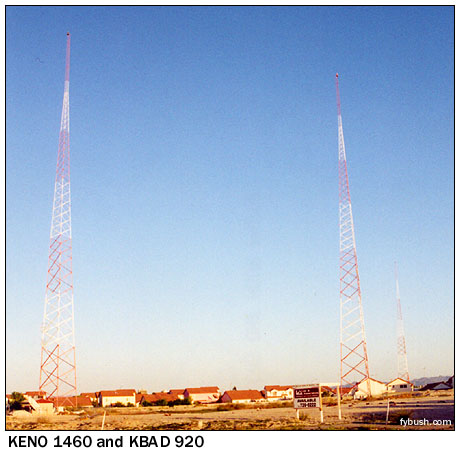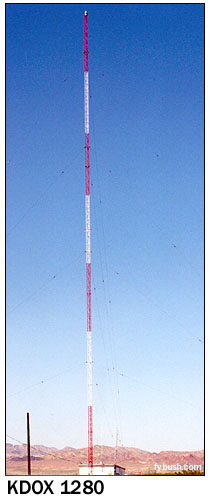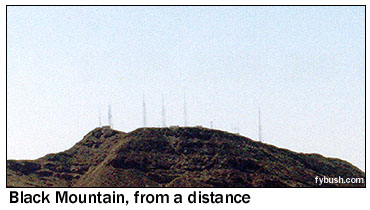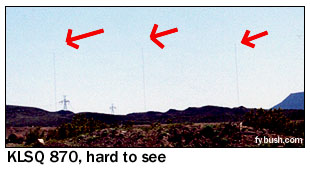
|
|
April 3-17, 2002
The Sticks of Sin City

Think of Las Vegas, and you probably come up with a mental image of the Strip, flashing neon, slot machines and showgirls - right? But there's a radio market here, too, and that means interesting sticks in the desert soil. We snapped these pictures a year ago, while in town for the NAB convention; if you're headed for this year's convention, as we are, you might see a few of these on your way around Vegas this year.

We began our visit to Las Vegas on the road, driving in from the north on I-15 after a visit to Zion National Park, St. George, Utah and the magnificent drive through the Virgin River Canyon in northwest Arizona, and that meant that our first sight of Las Vegas radio came about 20 miles north of the city, where US 93 splits from I-15 to head north through the barrenness of eastern Nevada on the way up to Ely.
That's where KXNT 840 sits, with five towers just south of 93, a mile or so off the exit. This station traces its heritage back to the old North Las Vegas signal on 1410 kHz, KVEG, which was granted a construction permit in the eighties to move down to 840 with 50 kW day and 25 kW nights.
Somewhere along the line, the 840 CP and the KVEG calls were sold, 1410 stayed on the air as KFMS(AM), and 840 made its debut in the late eighties as KVEG. In 1996, it went talk as KXNT, and so it remains today under Infinity ownership.
Head south into town, and I-15 takes you towards Nellis Air Force Base. Look to the east as you drive, and you'll see the five towers of the other North Las Vegas AM, KSFN 1140.
This was the old KLUC, the top-40 station in the valley. When that format migrated to the FM dial (KLUC-FM 98.5 still plays the hits in town, in fact), the AM side began a long progression of formats, including AC (KMJJ), very hard rock (KRSR, "The Crusher"), tourist information (KXNO, "Casino Radio"), sports (that's where the "KSFN" calls came from), a year or so of 50s oldies, and now a general talk format as a sister station to KXNO.


Continuing into town, we approach a batch of standalone sticks on the north side of town. While the south side is where you'll find the Strip and the big casinos, the north side is mostly small homes and industrial parks. Exiting I-15 at Cheyenne Avenue and heading west towards Martin Luther King brings us to the first of the single towers, KSHP 1400.
KSHP is the descendant of the old KVEG/KFMS(AM) on 1410, a victim of the increasing land values and the growth in Las Vegas' development in the nineties. The land where the old 1410 array sat became too valuable for the station by the mid-nineties, and in 1996 it moved from 1410 to this non-directional site on 1400 amidst the warehouses of North Las Vegas. If nothing else, there's a good view of the Vegas skyline to the south! (The thing to the right of the tower that looks like the CN Tower in Toronto is the Stratosphere Casino, the tallest structure in town...)
Diplexing is another popular Vegas solution to land costs: a couple of miles to the southwest, on Vegas Drive, sit three towers shared by two of the valley's oldest stations, KENO (1460) and KBAD (920). KBAD was once known as KORK, calls also heard on FM (97.1, now KXPT) and TV (Channel 3, still the NBC affiliate in town as KVBC). This was the original KORK site; KENO used to be southwest of town, at Decatur and Tropicana. Note the self-storage facility and housing development that sits between the two towers in front and the third in the rear!

 Head
east on Vegas Drive back towards I-15 and you'll come to another
old Las Vegas signal, KLAV 1230. Head south, and then west on
Charleston Boulevard, and you'll come to another shared tower
site: KRLV (1340) and a newer Vegas signal, daytimer KKVV (1060).
Head
east on Vegas Drive back towards I-15 and you'll come to another
old Las Vegas signal, KLAV 1230. Head south, and then west on
Charleston Boulevard, and you'll come to another shared tower
site: KRLV (1340) and a newer Vegas signal, daytimer KKVV (1060).
At this point, you're approaching Tourist Vegas; heading back east on Charleston lands you in downtown, and from there the Strip stretches south for several miles, lined with casinos, hotels and kitsch.
Some of the city's studio sites are near here, too; Infinity's complex is west of downtown on Charleston, Channel 3 is just north of downtown, and Channels 13 (KTNV, ABC) and 8 (KLAS, CBS) are just a few blocks off the Strip.
KTNV's studio facility on Valley View Drive has a self-supporting tower behind it that's easily seen from I-15 and the Strip; I suspect it was once the Channel 13 tower before all the market's TV and FM signals moved to the mountains south of town.
Continuing south, there's just one more AM site to be seen before the Las Vegas sprawl peters out into the narrow confines of I-15 and its nonstop stream of traffic back and forth from Southern California. If you've ever wondered what a radio tower looks like in Paradise, just check out the five towers of KNUU (970), Las Vegas' all-news AM outlet, licensed to - yes - Paradise, Nevada.
 The KNUU site just
west of Rainbow Boulevard near Sunset must once have been far
from any population, but that was before Vegas suburbia and the
new Clark County 215 freeway intervened.
The KNUU site just
west of Rainbow Boulevard near Sunset must once have been far
from any population, but that was before Vegas suburbia and the
new Clark County 215 freeway intervened.
Today, this site sits amidst new housing developments, right in the path of the future freeway expansion.
In fact, a check of the FCC records this year shows no sign of this site, so it appears KNUU may have already relocated to the new site another few miles to the south that was shown as a construction permit last year; we'll have to check it out when we're out there for NAB!
Late update: We drove out there as soon as we landed in Las Vegas, and the old site shown here is indeed history. The new site, with five towers at the very southern end of Rainbow, is in use - and we'll show you pictures as soon as we're back in town to upload them.
From Paradise, we backtrack to the booming suburbs that lie along US 93-95 (known officially, but to few in the Valley, as I-515) in Henderson. There are more studios out here, including Channels 10 (KLVX, public TV) and 5 (KVVU, Fox), but there are also some very interesting tower sites.


 The
AM that's licensed to Henderson is KDOX (1280), formerly known
as KDOL and, for at least a decade now, broadcasting in Spanish.
The
AM that's licensed to Henderson is KDOX (1280), formerly known
as KDOL and, for at least a decade now, broadcasting in Spanish.
This single stick off Lake Mead Drive isn't much to look at, to be sure, but from here you can look to the northwest and see the three towers of Las Vegas' only fulltime 50,000-watt station.
KDWN (720) signed on in 1975, in the first wave of the breakup of the clear channels. With a nondirectional signal by day and a directional signal at night to protect WGN in Chicago, it's been widely heard by DXers ever since. It's notable for three things: its talk hosts, who are so far to the right it's a wonder they haven't fallen off the edge of the flat earth; its Monday-morning silent period, which continued until just this year and its overnight host, a fellow named Art Bell who does the show from his home in nearby Pahrump. You've heard of him, maybe?
 From here, you can
look up Black Mountain to see one of the Las Vegas FM/TV tower
farms; there are actually two farms on separate peaks about four
miles apart up here, and they contain most of the FM and all
of the TV in the market.
From here, you can
look up Black Mountain to see one of the Las Vegas FM/TV tower
farms; there are actually two farms on separate peaks about four
miles apart up here, and they contain most of the FM and all
of the TV in the market.
A few FMs instead use Potosi Mountain, southwest of town; nearly all the signals in town are full Class C facilities, and their coverage of the valley is generally excellent. But we can't drive up the mountains in our little rental car, so we'll have to be content with the view from afar.
As we're viewing Black Mountain in the distance, we try to catch a glimpse of the most unusual Las Vegas-market AM facility there is. KLSQ (870) is licensed to Laughlin, the casino town on the Colorado River about 100 miles away, but for years it's operated a synchronous repeater licensed to East Las Vegas. We drive the dirt roads of a housing development on the southern fringe of Henderson until we catch a glimpse, just barely, of three of the skinniest unpainted towers we've ever seen. You can almost see them, too, in the photo above. (It's been rumored that KLSQ will give up the Laughlin facility and make this its primary transmitter; we can report hearing 870 just fine in Laughlin as well, so who knows...)
And with that, we leave Las Vegas behind - just in time to head back there for NAB 2002. Perhaps we'll see you out there; in any event, we'll be back in two weeks with a return to our home turf back East. Maybe it will have stopped snowing by then...
- Previous Site of the Week: We Love L.A., part III
- In Two Weeks: Bangor, Maine
- How can you help support Site of the Week? Click here!
- Submit your suggestions for a future Site of the Week!
